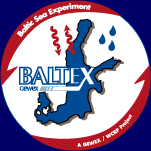Distributed BALTEX-relevant data bases
This page displays a list of accessible distributed meteorological, climatological, hydrological, oceanographical and environmental data bases from the entire Baltic Sea basin. Some data are easily accessible through the linked web sites, others require a registration procedure. The list is subject to constant updates, so suggestions for new links are welcome (send to baltex@hzg.de).
1. The BALTEX Phase I Data Centres (completed, but data still available, see here...)
2. Meteorological and climatological data
World Data Center for Climate (WDCC)
The WDCC provides web-browser access mainly to climate model data. The "Browse Experiment" option provides tree-like access to global and regional model data. Data of potential BALTEX interest can be obtained directly from the following WDCC server:
- BALTEX (Baltex Meteorological Data Centre (BMDC)
- CLM_regional_climate_model_runs (The climate version of the local model (CLM) of the DWD was used to simulate the regional climate of the 20th century (1960-2000) and 21st century (2001-2100) in Europe.)
- Webportal of IPCC data
- IPCC-DDC (The IPCC Data Distribution Centre privides access to selected monthly means from climate model scenario calculations for the last three assessment reports): AR1/ AR2 / AR3 / AR4
- IPCC AR4 Hamburg: ECHAM5-MPI-OM experiments (IPCC-Hamburg Climate Model Simulations providing access to results from a set of four scenarios families (A1, A2, B1, B2) which have been calculated with the EHAM5/MPI-OM global earth system model)
- REMO-UBA (REMO-Simulations on 10km horizontal resolution: Three high resolution regional IPCC scenarios (A2, A1B and B1) for Germany, Austria and Switzerland have been performed using the regional climate model REMO driven by results from the coupled ocean atmosphere model ECHAM5-MPIOM.)
For data access, a user account must be obtained by sending an e-mail request to data(at)dkrz.de and specifying name, institute and at least E-mail adress of scientist. Additionally, BALTEX and the scientific project is requested to classify data downloads for internal WDCC user statistics.
WebWerdis
WebWerdis, is the Weather Request and Distribution System of DWD. Climatological and meteorological information from selected weather stations across Germany, Norway, Finland (and the Republic of Korea) are available on this server.
Coordinated Enhanced Observation Period (CEOP)
CEOP (Coordinated Enhanced Observing Period) was an element of WCRP-GEWEX to establish a global observing system for the water cycle. CEOP-I was an effort to address some of the critical aspects of the climate system involving land areas in particular over a 2 year period beginning in mid-2001 and ending December 2004. It focused on two overall issues: water and energy fluxes and reservoirs over land areas, monsoonal circulations.
ENSEMBLES
The ENSEMBLES project was an EU 6th Framework Programme from 2004-2009, aiming to dDevelop an ensemble prediction system for climate change based on the principal state-of-the-art, high resolution, global and regional Earth System models developed in Europe, validated against quality controlled, high resolution gridded datasets for Europe, to produce for the first time, an objective probabilistic estimate of uncertainty in future climate at the seasonal to decadal and longer timescales.
PRUDENCE
The PRUDENCE project was the first RCM intercomparison project, running from 2001-2004. It was a European-scale investigation to address and reduce deficiencies in projections and to quantify confidences and uncertainties in predictions of future climate and its impacts by using an array of climate models and impact models. On the project home page you will also find a direct link to freeley available model data.
The Climate Explorer
Web data interface for worldwide climatological data; by the KNMI (Royal Netherlands Meteorological Institute). Data from the BALTEX area available.
"Poor man´s re-analysis over Europe"
Report by Peter Berg and Jens Hesselbjerg Christensen (from the FP6 project WATCH)
3. Oceanographic data
The Baltic Sea Portal
A joint information web site by the Finnish Environment Institut SYKE and the Finnish Meteorological Institute FMI on oceanographic Baltic Sea data: sea ice maps, data on hydrography, ocean color, algal distributions, current and archieved BMP monitoring data.
The German Federal Maritime and Hydrographic Agency (BSH)
Marine data (satellite SST, color, hydrography, MARNET Monitoring data) and a variety of charts and maps.
FMI Polar View Products
Baltic Sea ice thickness chart and ice forecasts from the Finnish Meteorological Institute (FMI)
AMSR-E Sea Ice Concentrations (ice coverage)
AMSR satellite data on sea ice concentration, daily updated in winter. Also daily Baltic Sea ice cover is available.
Modis Rapid Response System
Modis satellite images in visible true colour and real time; global, but there are daily images of the Baltic Sea region.
4. Hydrological data
The Global Runoff Data Centre (GRDC)
World-wide depository of discharge data and associated metadata (a small handling fee may by charged) |

